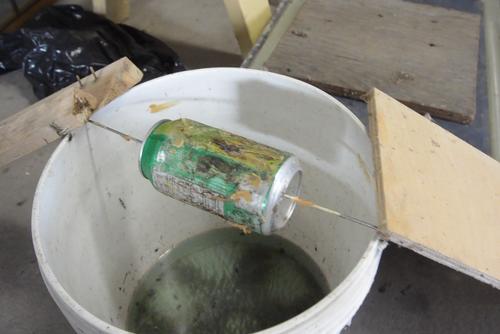 My mom has been using this style of drowning mouse trap at the
cottages the last few years.
The advantage of this trap is that it can catch many mice in one trap.
My mom has been using this style of drowning mouse trap at the
cottages the last few years.
The advantage of this trap is that it can catch many mice in one trap.
 My mom has been using this style of drowning mouse trap at the
cottages the last few years.
The advantage of this trap is that it can catch many mice in one trap.
My mom has been using this style of drowning mouse trap at the
cottages the last few years.
The advantage of this trap is that it can catch many mice in one trap.
The trap consists of a coat hanger wire across the bucket, with an aluminium can on the wire. The can has peanut butter smeared onto it. As the mouse tries to get at the bait, the can spins, and the mouse falls into the bucket.
I started using this style of trap in my workshop in the country. But I was curious to see how the mice actually used it. When I tried monitoring it last spring there weren't any mice in the shop. The mouse problem peaks in the fall when the mice look for an escape from the cold, so this fall (2015) I tried again.
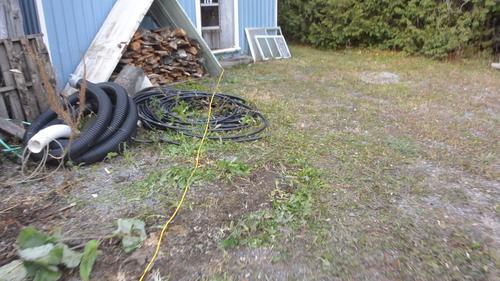 I wanted to observe how the mice actually got caught in the trap by monitoring it
with my Raspberry Pi and camera module
and my imgcomp software.
I wanted to observe how the mice actually got caught in the trap by monitoring it
with my Raspberry Pi and camera module
and my imgcomp software.
In the mean time I had sealed my workshop against mice a bit better, so I set up my experiment in a shed, running an extension cord to power my setup.
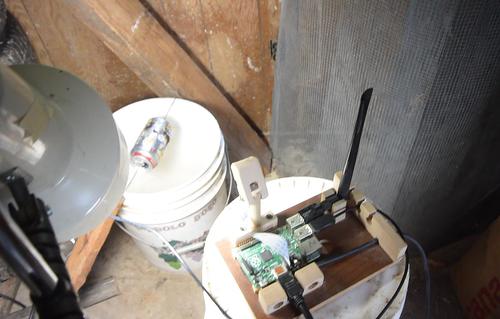 The monitoring setup consists of a Raspberry Pi model B+, mounted on my
Raspberry pi and camera module holder.
The camera is aimed at the trap. The pi is running some software that I wrote
for surveillance. It takes three pictures per second, and if it sees any changes
from one to the next, it saves it.
The monitoring setup consists of a Raspberry Pi model B+, mounted on my
Raspberry pi and camera module holder.
The camera is aimed at the trap. The pi is running some software that I wrote
for surveillance. It takes three pictures per second, and if it sees any changes
from one to the next, it saves it.
I also have a lamp aimed at the setup with my. Mice do come out even when it's light so long as it's quiet.
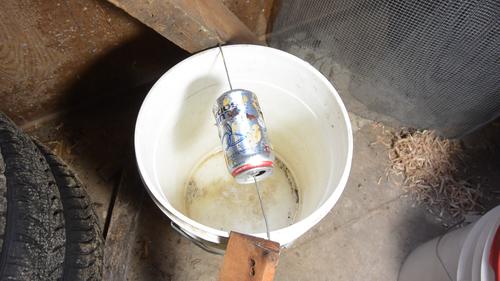 I didn't put any water in the bucket this time. I didn't want to
show mice getting killed on YouTube. The mice can just barely jump out of
the bucket. I figure that way, the mouse gets a second chance, and I get
more observations.
I didn't put any water in the bucket this time. I didn't want to
show mice getting killed on YouTube. The mice can just barely jump out of
the bucket. I figure that way, the mouse gets a second chance, and I get
more observations.
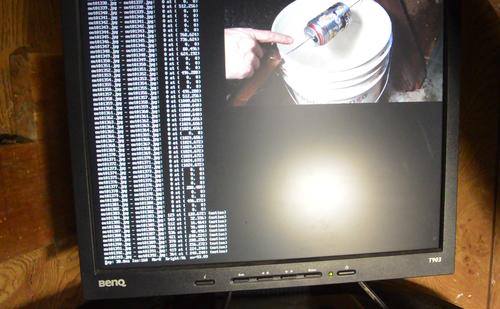 Checking the setup with my imgcomp software.
As soon as my hand enters the field of view, my
software detects motion and records it.
Checking the setup with my imgcomp software.
As soon as my hand enters the field of view, my
software detects motion and records it.
Next I moved the can closer to the edge of the bucket to make
it more enticing. But this only resulted in the mouse systematically eating
all the bait within reach, never trusting the can enough to get
fully on it. It even deliberately rotated the can to get at more bait.
Clever mouse!
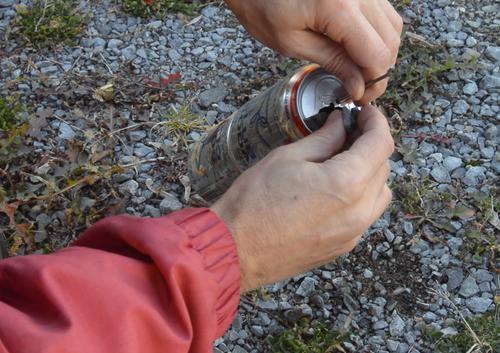 My next thought was to give the mouse a semi-stable perch in the form
of a "weighted" can. So I put a few small stones in one can, which I put
next to another freely spinning can.
My next thought was to give the mouse a semi-stable perch in the form
of a "weighted" can. So I put a few small stones in one can, which I put
next to another freely spinning can.
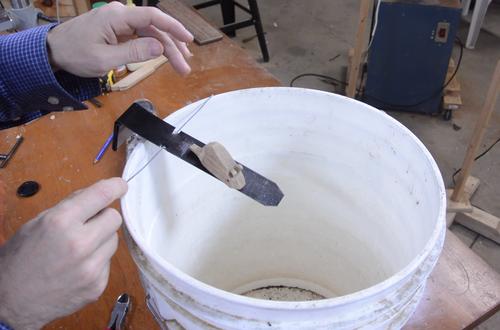 The weighted can clearly works and is better at catching mice than the
un-weighted can.
The weighted can clearly works and is better at catching mice than the
un-weighted can.
But I had another idea: a tipping ramp. As the mouse gets nearer the front, the ramp tips down, dumping the mouse into the bucket.
I tried making a ramp out of some 30 mm wide metal strapping, bending the strapping over several times to form a counterweight on the back. But this ramp was heavy. With all it inertia, it would tip slowly, giving the mouse time to scurry back to safety.
I wanted a ramp that would dump spontaneously without warning.
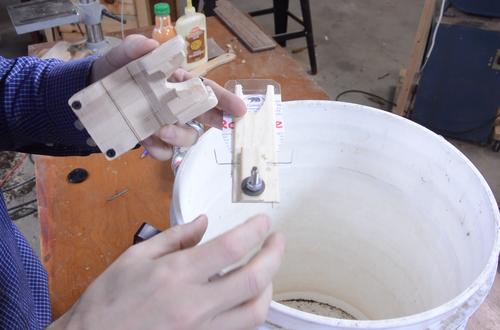 So here is the design I came up with.
So here is the design I came up with.
It's a very light wooden ramp, with a screw in the back for a counterweight. The top of the ramp has some plastic on it from some packaging so that it's too smooth for the mouse to claw into.
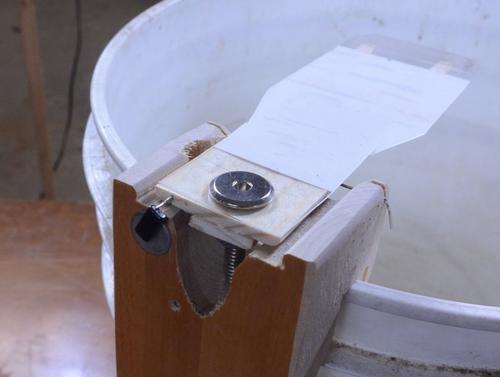 The counterweight is only heavy enough to bring the ramp back to horizontal. The ramp
is mostly held up by a very small magnet in the back, which pulls down on a piece of
paper clip wire on the back of the ramp.
The counterweight is only heavy enough to bring the ramp back to horizontal. The ramp
is mostly held up by a very small magnet in the back, which pulls down on a piece of
paper clip wire on the back of the ramp.
The magnet is stuck to a washer by it's own magnetism. That way, I can tweak its position.
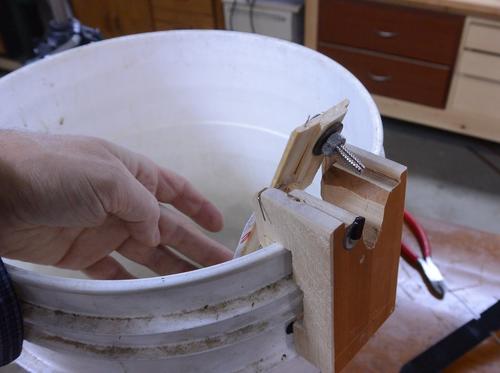 The idea is that the magnet holds the ramp well enough for the mouse to get onto
the ramp, but once its force is exceeded and it starts to tip, the holding power of
the magnet drops rapidly with distance.
So basically, the ramp appears stable until it gets too much load, and then it dumps
spontaneously.
The idea is that the magnet holds the ramp well enough for the mouse to get onto
the ramp, but once its force is exceeded and it starts to tip, the holding power of
the magnet drops rapidly with distance.
So basically, the ramp appears stable until it gets too much load, and then it dumps
spontaneously.
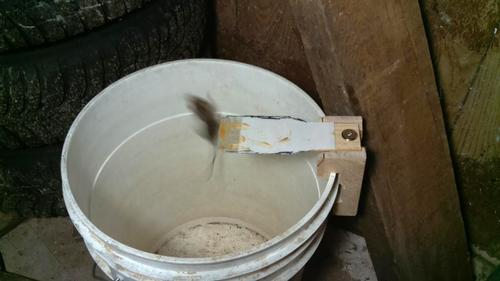 This ramp worked exceedingly well. The same mouse would get on it time and time again!
Very satisfying to watch!
This ramp worked exceedingly well. The same mouse would get on it time and time again!
Very satisfying to watch!
Also interesting to watch the mouse get out of the bucket. Unfortunately, at 3 frames per second, it was hard to see how the jumping happened. The mouse is able to jump to nearly the edge of the bucket.
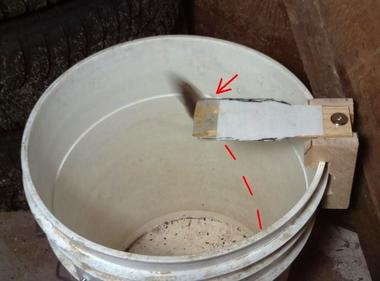
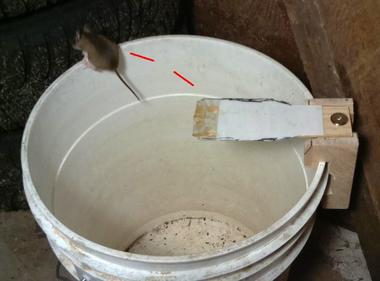 These two frames are very revealing about how the mouse got out.
In the left frame, you can see a mouse paw on the slight ledge of the
bucket, and in the next frame, the mouse is on the bucket's edge,
further to the left.
These two frames are very revealing about how the mouse got out.
In the left frame, you can see a mouse paw on the slight ledge of the
bucket, and in the next frame, the mouse is on the bucket's edge,
further to the left.
So the mouse jumped in a more or less helical path. This meant the mouse had some momentum towards the wall, which allowed it to get a slight boost with one of its paws off the narrow beveled ledge in the bucket, and that was enough to make it up to the rim. Clever mouse!
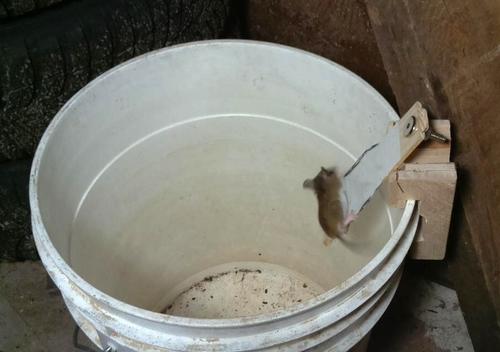
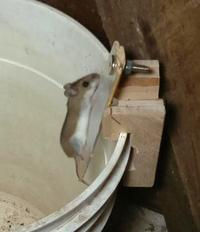 Over time, the mouse wised-up to the trap, grabbing hold of the edges of the
ramp as it went down. Though sometimes it still fell in while trying to
climb back up.
Over time, the mouse wised-up to the trap, grabbing hold of the edges of the
ramp as it went down. Though sometimes it still fell in while trying to
climb back up.
A possible improvement would be to make the ramp edges curve down with a larger radius so the mouse couldn't grab onto them. Though, realistically, this is only a problem once the mouse gets practice with the trap. If there was water in the trap, the mouse would be long dead before it had a chance to figure it out.
But the ramp-based trap is very tricky to make and tweak just right, so I wouldn't recommend you build one like that. The un-weighted can on a coat hanger wire works (caught quite a few mice with it in the past). And weighting the can makes it semi-stable, which makes the mouse more likely to get on it and fall off.
See also:
Imgcomp -- The software I used for this video.
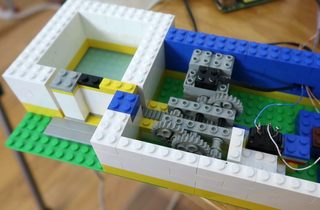 Mouse experiment setup vlog (video only)
Mouse experiment setup vlog (video only)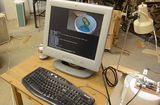 High tech mousetrap monitor fail (video only)
High tech mousetrap monitor fail (video only)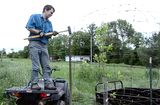 Anti-deer tree cage
Anti-deer tree cage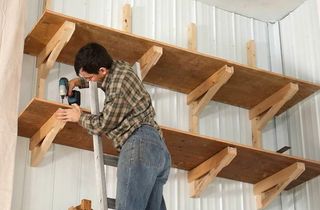 Up-high garage shelves (mouse proof)
Up-high garage shelves (mouse proof)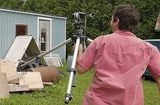 The steadycam you
The steadycam you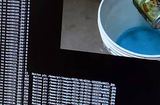 My imgcomp program (motion triggered time-lapses)
My imgcomp program (motion triggered time-lapses) Burning branches and crap (video only)
Burning branches and crap (video only)